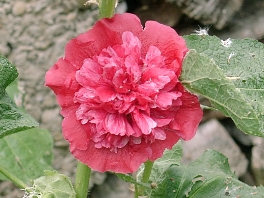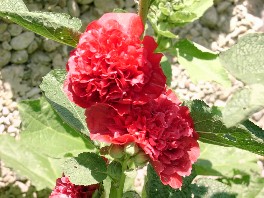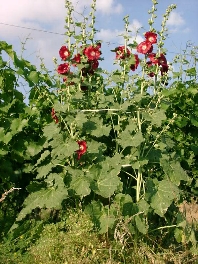 In european gardens you can see the Hollyhock very often
because of its beautiful flowers.
The plant grows taller than a man and carries huge red flowers along its stem.
In european gardens you can see the Hollyhock very often
because of its beautiful flowers.
The plant grows taller than a man and carries huge red flowers along its stem.
Like its relatives from the mallow family the Hollyhock helps against cough and other problems of the respiratory organs.
It is also helpful for skin problems.
Medicinal Uses
- Inflammation-adverse
- Softening
- Diuretic
- Spasm-dissolvent
- Loss of appetite
- Mouth inflammations
- Pharyngeal inflammations
- Strep throat
- Vocal chord inflammation
- Cold
- Bronchitis
- Coughs
- Fever
- Stomach inflammation
- Intestinal inflammation
- Diarrhea
- Menses forcing
- Discharge
- Eczemas
- Skin inflammations
- Wounds
- Burns
- Ulcers
Information
| Used Parts: | Flowers, Leaves, Root, Seeds |
| Substances: | Mucus, Tannic acid, Anthocyanin, essential oil |
| Time to collect: | July and August |
| Other names: | Garden mallow |
Methods
 Mainly the flowers are used from the Hollyhock,
but you can also use the leaves, root and seeds.
Mainly the flowers are used from the Hollyhock,
but you can also use the leaves, root and seeds.
As the Hollyhock is similar to its relatives, the Marsh Mallow, Dwarf Mallow and Red Sorrel, it can help against similar problems.
The most important substance in the Hollyhock is the mucus. It has an emollient effect.
This effect makes the Hollyhock to a good herbal remedy against problems of the pulmonary system. But it can also help against skin problems an diseases of the digestion.
Internal use
Flowers
You can make a tea out of the flowers. Best you do it as a cold infusion to save the fragile flowers and the mucus.But when the Hollyhock is a part of a tea-mixture you can prepare it as an infusion.
Drink the tea against cough, bronchitis or a soar throat.
You can also use it to gargle against throat or mouth inflammation.
Root
The root of the Hollyhock can be used similar to the uses of the flowers, because it also contains mucus and tannic acid.You can use it against diarrhea and other problems of the digestive system. It is also good against loss of appetite.
Seeds
The seeds can be used against fever,They have a diuretic and amollient effect.
External use
You can use the tea of the hollyhock as a compress against a lot of different skin problems.It helps against inflammations and encourages the healing processes of the skin.
Using as a sitz bath the hollyhock can help against discharge.
Plant description
 Originally the Hollyhock comes from south east Europe.
But you can find it also in a lot of gardens due to its beauty.
Originally the Hollyhock comes from south east Europe.
But you can find it also in a lot of gardens due to its beauty.
The Hollyhock is a biennial or perennial plant. It becomes more than two meters high.
In the first year it has only leaves near the ground. In later years the leaves grow up to the flowers. The hairy leaves are big and lobed and grow on stalks.
The big flowers blossom from july to august. Originally they where all blakish red but now Hollyhocks can have flowers in all kinds of red. The flowers grow directly on the central stem.
